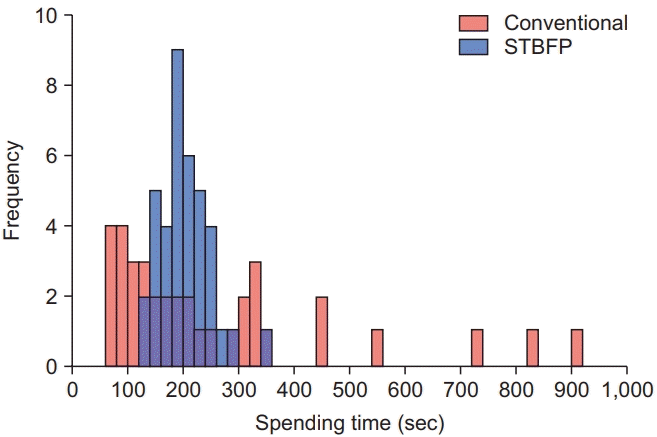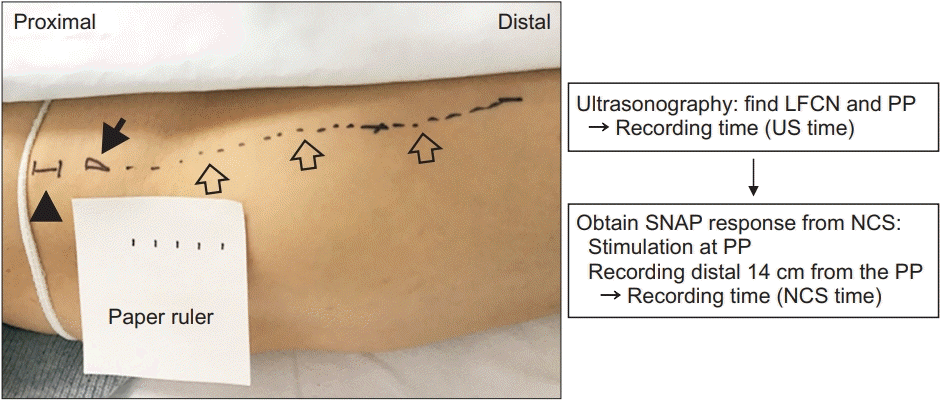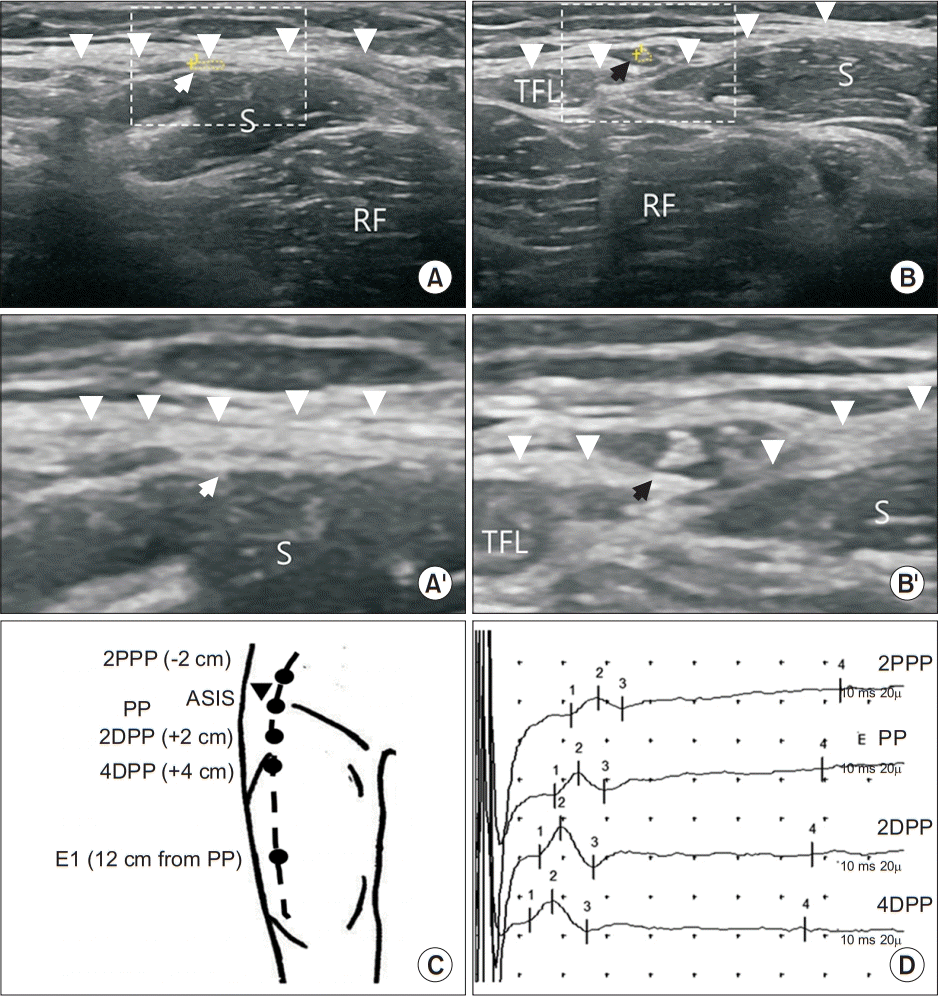INTRODUCTION
The lateral femoral cutaneous nerve (LFCN) is derived from the posterior divisions of the L2 and L3 spinal nerves. The nerve originates within the psoas major and passes across the iliac fossa beneath the iliac fascia, traveling toward the medial side of the anterior superior iliac spine (ASIS). It passes behind or through the iliac ligament and enters the thigh with highly variable anatomical courses [
1]. In the thigh, the nerve penetrates the fascia lata and divides into terminal branches to innervate the anterolateral skin of the thigh [
2].
Meralgia paresthetica is a condition characterized by tingling, numbness, and burning pain in the anterolateral thigh and is usually caused by damage to the LFCN [
3]. Sensory nerve conduction studies help identifying LFCN lesions. The procedure involves stimulating the LFCN 1 cm medial to the ASIS and recording at a distance of 12–16 cm along the line extending from the ASIS to the lateral border of the patella, to obtain the sensory nerve action potential (SNAP) response of the LFCN [
4]. However, this conventional LFCN conduction technique has a limitation owing to its deep position and anatomical variations in the inguinal area and proximal leg [
5]. To obtain accurate SNAPs of the LFCN, various techniques have been developed, such as ultrasound for the localization of the LFCN [
6,
7], subdermal needle recording [
8], and assessment of LFCN conduction in the distal thigh [
5].
Recently, several studies reported the effect of fascia on conduction studies of cutaneous nerves, suggesting that stimulation based on the fascia penetration point (PP) can produce more accurate and reliable SNAP results [
9,
10]. According to previous studies, SNAP amplitude was the highest when the nerve was stimulated immediately after penetrating the fascia [
9,
10]. Increased depth from the skin to the nerve, low conductivity of fat, and large electrical conduction activity of the fascia itself can interfere with nerve action potentials and decrease SNAP amplitudes in sensory nerve conduction. Similar to other cutaneous nerves, the LFCN is located below the fascia of the iliacus muscle and penetrates the fascia in the thigh, becoming superficial. Therefore, we hypothesized whether stimulation around the fascia PP of the LFCN can improve the measurement of nerve conduction study (NCS) parameters. To this end, we aimed to identify the effect of fascia penetration in LFCN conduction study and to compare the stimulation technique based on the fascia penetration point (STBFP) with the conventional technique.
Go to :

RESULTS
The demographics of the 40 subjects are shown in
Table 1. In the STBFP group, the mean cross-sectional area of the LFCN at the PP was 1.50±0.55 mm
2 and the mean distance between the LFCN at the PP and the inferior margin of the ASIS was 1.60±1.29 cm (range, 0.50–6.00 cm) distal to the ASIS.
Table 1.
Characteristics of the subjects studied
|
Conventionala) (n=20) |
STBFPb) (n=20) |
p-value |
|
Sex, female |
19 |
19 |
|
|
Age (yr) |
49.00 (12.75) |
51.00 (11.75) |
0.968 |
|
Body weight (kg) |
55.50 (12.65) |
56.50 (12.38) |
0.547 |
|
Height (cm) |
160.12±5.24 |
161.71±5.62 |
0.389 |
|
BMI (kg/m2) |
22.76±2.80 |
22.42±2.18 |
0.653 |
|
Leg length (cm) |
77.30±3.73 |
79.00±4.02 |
0.173 |

The results of the sensory NCS of the LFCN obtained from the two techniques are shown in
Table 2. Using the conventional technique, 4 of 20 subjects showed no SNAP response in both the legs, whereas using STBFP, 2 of 20 subjects showed no SNAP response in only one leg. Statistical analysis showed that the response rate of STBFP was significantly higher than that of the conventional technique (p=0.041). The mean SNAP amplitude in the STBFP group was slightly higher than that in the conventional conduction group, although there was no significant difference between the two groups. The negative peak latency measured by STBFP was delayed by a small difference compared with that measured by the conventional technique. The median time spent in the STBFP group (the time from the placement of the ultrasound transducer on the skin to marking the course of the LFCN using ultrasound + time taken to obtain the LFCN SNAP) was 197.50 seconds (IQR, 56.75 seconds), which was comparable to that of the conventional conduction group (median time, 178.50 seconds; IQR, 225.50 seconds). However, a histogram of the time spent on the two techniques showed that STBFP took a more consistent time than the conventional technique (
Fig. 3). The time spent on the conventional technique was variable (60.00–989.00 seconds), but the time spent on STBFP was consistent (126.00–345.00 seconds). The overall distributions of the time spent on the two techniques were significantly different (two-sample Kolmogorov–Smirnov test, p<0.05). There were no significant differences in the VAS scores for pain during NCS (4.52±1.74 vs. 3.90±1.61) between the two groups.
 | Fig. 3.Comparison of time spent on conventional technique and STBFP. Histogram shows spending time of two techniques, conventional technique (red) and STBFP (blue). The distribution of two histograms are significantly different according to the two-sample KolmogorovSmirnov test (D=0.342, p-value=0.0173). STBFP, stimulation based on fascia penetration. 
|
Table 2.
SNAP amplitudes, latencies, no response, time spent, and VAS scores in comparison of the two techniques
|
Conventional |
STBFP |
p-value |
|
Recording (cm) |
14 |
14 |
|
|
Peak latency (ms) |
2.62±0.18 |
2.75±0.21 |
0.006*b)
|
|
Amplitude (µV) |
6.97±2.16 |
7.68±2.00 |
0.164b)
|
|
No response |
|
|
0.041*d)
|
|
Subjects (n=20) |
4 |
2 |
|
|
Legs (n=40) |
8 |
2 |
|
|
Time (s) |
178.50 (225.50) |
197.50 (56.75) |
0.419c)
|
|
Ultrasonographya) (s) |
- |
125.55±36.81 |
|
|
VAS score |
4.52±1.74 |
3.90±1.61 |
0.244b)
|

SNAPs of the LFCN obtained from the four different stimulation sites based on the fascia PP are shown in
Fig. 2D. There were significant differences between the 2PPP, PP, 2DPP, and 4DPP sites in terms of negative peak latencies and amplitudes (p<0.001 with Kruskal–Wallis test) (
Table 3). Post-hoc analysis using the Mann–Whitney U test with Bonferroni correction showed that the SNAP amplitudes at the PP and 2DPP were significantly higher than those at the other test points (
Fig. 4A). However, there was no significant difference in the SNAP amplitude between the PP and 2DPP sites. Negative peak latency was different at all four points (
Fig. 4B).
 | Fig. 4.Comparison of parameters between four different stimulation points based on the PP in the lateral femoral cutaneous nerve conduction study. (A) SNAP amplitude and (B) SNAP negative peak latency at each stimulation point as median and interquartile range. *p<0.0083 comparison by post-hoc analysis (Mann-Whitney U test with Bonferroni correction), significant differences between groups. SNAP, sensory nerve action potential; 2PPP, 2 cm proximal to the penetration point; PP, penetration point; 2DPP, 2 cm distal to the penetration point; 4DPP, 4 cm distal to the penetration point. 
|
Table 3.
Sensory nerve conduction study of the lateral femoral cutaneous nerve based on PP
|
2PPP |
PP |
2DPP |
4DPP |
p-value |
|
Peak latency (ms) |
2.75 (0.36) |
2.45 (0.25) |
2.10 (0.20) |
1.85 (0.19) |
<0.001*
|
|
Amplitude (µV) |
6.50 (1.88) |
7.75 (2.70) |
8.20 (2.80) |
6.80 (3.40) |
<0.001*
|

Go to :

DISCUSSION
Our study shows that fascia penetration has a significant effect on sensory nerve conduction of the LFCN. Because the fascia conducts electricity better than subcutaneous fat, the electrical stimulation can be transmitted unequally around the fascia, causing interference of the nerve action potentials and reducing the SNAP amplitude [
10]. Furthermore, in the abdominal and inguinal area, there is usually a significant amount of peritoneal fat and connective tissue around the LFCN, which may interfere with the conduction of electrical activity [
11]. Therefore, it is plausible that stimulation of the nerve at the point piercing the fascia and positioning beneath the skin can obtain larger SNAP amplitudes. To test our hypothesis, we identified the fascia PP of the LFCN using ultrasonography and stimulated the LFCN at four different stimulation sites based on the fascia PP. The results showed that LFCN stimulation between the PP and 2DPP sites had significantly higher SNAP amplitudes than those at other stimulation points, suggesting that the fascia PP should be considered in LFCN conduction studies. Previous studies have reported the effects of fascia penetration on several nerves [
9,
10], but the LFCN has not been studied. This is the first study to evaluate the fascia penetration effect in nerve stimulation for LFCN conduction.
Different anatomical variations of the LFCN are major obstacles in obtaining consistent results in nerve conduction studies. Several techniques have been developed for obtaining LFCN SNAPs. Spevak and Prevec [
5] stimulated the LFCN on the thigh with standard surface bipolar electrodes placed 6–10 cm below the ASIS, where the nerve usually lies underneath the skin, yielding low SNAP amplitudes with small variability. Two studies proposed a method of measuring the LFCN SNAP by visualizing the nerve using ultrasound and placing a surface electrode on it [
6,
7]. Deimel et al. [
8] reported that the ultrasoundguided near-nerve needle recording method for LFCN conduction studies could be helpful when the surface recording of the LFCN elicits no response. Previously studied techniques mainly focused on medial or lateral positioning of the stimulation electrode, only at the level of the ASIS or the inguinal ligament [
4,
12]. Our study suggests that the proper stimulation point, considering the fascia PP of the LFCN, is approximately 1–3 cm distal to the ASIS. The STBFP LFCN conduction technique, developed by applying this electrophysiological effect of fascia penetration, may be helpful in improving the quality of LFCN conduction. To determine whether STBFP can obtain more accurate SNAP parameters than the previous ultrasound-guided conduction technique, further comparative studies using the two techniques are necessary.
The STBFP may be more beneficial than conventional LFCN conduction. First, the STBFP was found to have a higher detection rate for the SNAP response of the LFCN; the STBFP obtained SNAPs in 38 of 40 legs, whereas the conventional technique obtained SNAPs in 32 of 40 legs. Fisher exact test showed that the SNAP response strongly correlated with STBFP, and the odds ratio was 5.33. Furthermore, in terms of time, the ultrasound detection of the LFCN did not require a substantial amount of time. The average time for localization of the LFCN using ultrasound was approximately 2 minutes, and the time to obtain a SNAP response was approximately 80 seconds. Although the total time taken by STBFP was not significantly different compared with the conventional technique, variability of the time spent remarkably decreased when using STBFP. A consistent and stable procedure time when using STBFP can reduce patient discomfort during NCS.
In this study, ultrasonography revealed that the LFCN pierces the fascia lata at an average of 1–3 cm distal to the inferior margin of the ASIS. The fascia PP in this study showed less variation and more proximal location, compared with previous cadaveric studies, which demonstrated that the LFCN usually pierces the fascia lata at approximately 5–10 cm distal to the inguinal ligament [
3,
13,
14]. Ray et al. [
15] reported that the mean distance between the ASIS and the point where the anterior division of the LFCN pierced the deep fascia of the thigh to become cutaneous was 18.84±8.58 cm (range, 3–30.5 cm), with significant variations. The distal superficial branches of the LFCN pierce the fascia lata at 9.5±4.9 cm (range, 3.1–23.2 cm) distal to the inguinal ligament [
16]. As shown in previous studies, the fascia PP is extremely variable, and most studies have examined Western populations using cadaveric studies. In this study, most subjects were Asian women. Different leg lengths and ethnicities might be a cause of the different results. Furthermore, the exact point at which the LFCN becomes superficial in the thigh may vary, like the anatomical variation of the LFCN course.
On comparison of the LFCN SNAP parameters of the conventional technique with those of STBFP, the negative peak latency of the conventional technique was slightly shorter than that of STBFP, although the distance from the stimulation electrode to the recording electrode was the same (
Table 2). Because the LFCN runs deep under the inguinal ligament and its depth is extremely variable [
17], its depth can change rapidly as the nerve passes around the ASIS. Therefore, when nerve stimulation is performed near the ASIS using the conventional technique, the nerve may not be stimulated just below the stimulation electrode, but at a slightly distal point where the nerve becomes superficial, in some cases. This would have the effect of shortening the actual distance between the stimulation point and the recording electrode, thereby reducing the negative peak latency in the conventional technique.
In some subjects, the fascia PP was quite distal, making it difficult to reliably track the nerve at a distal site 8–10 cm beyond the PP. For the comparison study of the SNAP response obtained by changing the stimulation site based on the fascia PP (
Table 3), we placed the recording electrode 12 cm distal rather than 14 cm distal to the PP for stable recording. In the 4DPP stimulation, the distance between the stimulation electrode and the recording electrode was too short (8 cm); thus, stimulus artifacts occurred, and the amplitude was reduced. Because the SNAP amplitude of the LFCN was relatively small and subcutaneous fat required strong stimulations for LFCN conduction, stimulus artifacts could not be completely avoided at the 4DPP stimulation, despite strict adherence to the principles for reducing stimulus artifacts, including anodal rotation.
As there were steps involving examiners, such as ultrasound and nerve conduction, it was challenging to design a study that maintained objectivity and avoided bias. To directly compare STBFP with the conventional technique, it may be appropriate to perform the two techniques simultaneously on one subject, but differences in skill between examiners can affect the results. If one examiner performs the two techniques sequentially on one subject, there is a risk of performance bias affected by the order of the procedures. Therefore, we thought that performing each technique on two subjects assigned via rigorous random allocation would reduce the performance bias caused by ultrasound and NCS examiners and would produce the most objective study.
Our study had several limitations. First, we did not examine meralgia paresthetica patients. The diagnostic application of STBFP to meralgia paresthetica patients requires further validation and comparative studies in normal control and symptomatic patients. Second, although the nerve location was determined using ultrasound for the LFCN conduction study, there were two subjects with no response, and the cause of the lack of response was not identified. The proportion of subjects with no SNAP response in our results is similar to that reported in previous studies on LFCN conduction [
6,
7]. In the ultrasound-guided NCS by Boon et al. [
6], 1 in 50 subjects showed no response, and in the study by Park et al. [
7], 1 in 29 subjects showed no response. Further studies are required to evaluate whether the SNAP response can be evoked in unresponsive subjects by applying a near-needle stimulation technique, as shown in a study by Boon et al. [
6]. Meanwhile, we attempted to include only healthy subjects in this study through history taking, but it is possible that patients with asymptomatic lateral femoral cutaneous neuropathy or polyneuropathy were accidentally included in this study. Third, the small sample size and the sex ratio being biased toward women are other limitations of this study. Large-scale studies with similar sex ratios are required for reaching a generalized conclusion. Fourth, the time spent on each technique was measured only during the performance of ultrasonography or NCS, not during preparation or setup. Therefore, the actual time required for STBFP may be different, according to individual laboratory settings. Finally, questionnaires rather than VAS scores may be suitable for assessing the discomfort of subjects during the NCS examination.
The stimulation between the PP and 2DPP sites produced larger amplitude SNAPs than the stimulation at other points in the LFCN conduction study. The STBFP could increase the response rate and ensure consistent procedure time of the LFCN conduction study, compared with the conventional technique. For clinical application, further studies are needed to evaluate the diagnostic role of STBFP in patients with meralgia paresthetica.
Go to :









 PDF
PDF Citation
Citation Print
Print



 XML Download
XML Download